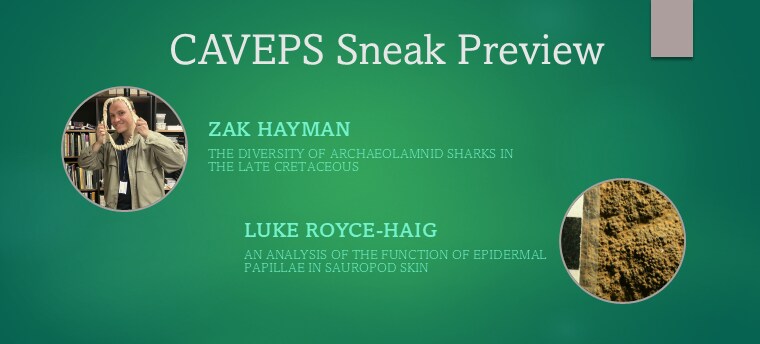
Join us for talks from two of our HDR students who are headed to CAVEPS in November. The Conference of Australasian Vertebrate Evolution, Palaeontology and Systematics is held every two years and an opportunity for vertebrate palaeontologists to share their research.
Zak Hayman & Luke Royce-Haig from Dinolab in the Palaeoscience Research Centre would like to share with our UNE students a sneak preview of what they are taking to CAVEPS.
In person in the Museum seminar room, or online in Gathertown. Be sure to request a guest pass when registering if you do not have a UNE email address!
Zak Hayman: The diversity of archaeolamnid sharks in the Late Cretaceous
Lamniform sharks represent one of the nine modern orders of sharks, with 15 living species. In the Late Cretaceous however, lamniforms were the predominant group of sharks that swam alongside an array of marine reptiles, with dozens of fossil species known globally. Despite this, much of their Cretaceous diversity remains obscured due to superficial similarities in tooth shapes shared by many species. The Archaeolamnidae is one such lamniform group suffering this conundrum, with teeth referrable to the titular species Archaeolamna kopingensis spanning a range of nearly 30 million years. Let’s see how well this holds up under some qualitative and quantitative scrutiny…
Luke Royce-Haig: An analysis of the function of epidermal papillae in sauropod skin
Sauropod dinosaurs represent the largest known terrestrial animals in the history of life on earth, with large taxa potentially exceeding 50 tons in mass. As a result, the implications of this extreme gigantism have become a dominant theme in the scholarship surrounding these animals. One of the key challenges faced by large-bodied animals is thermoregulation. Due to high thermal inertia, large animals have issues dissipating heat effectively. Due to their often immense sizes, it is likely sauropods would have been particularly vulnerable to this issue. While numerous thermoregulatory adapations have already been proposed, sauropod skin has received little prior academic attention. Sauropod integument is notable for the presence of epidermal papillae (small, dome-like structures) across the surface of the scales. It is hypothesized that these papillae may have aided thermoregulation by increasing the surface area of the animal.
| Ticket Type | Price | |
|---|---|---|
| Monthly Seminar - In Person | $0.00 | Sale Ended |
| Monthly Seminar - Online | $0.00 | Sale Ended |

New South Wales, Australia